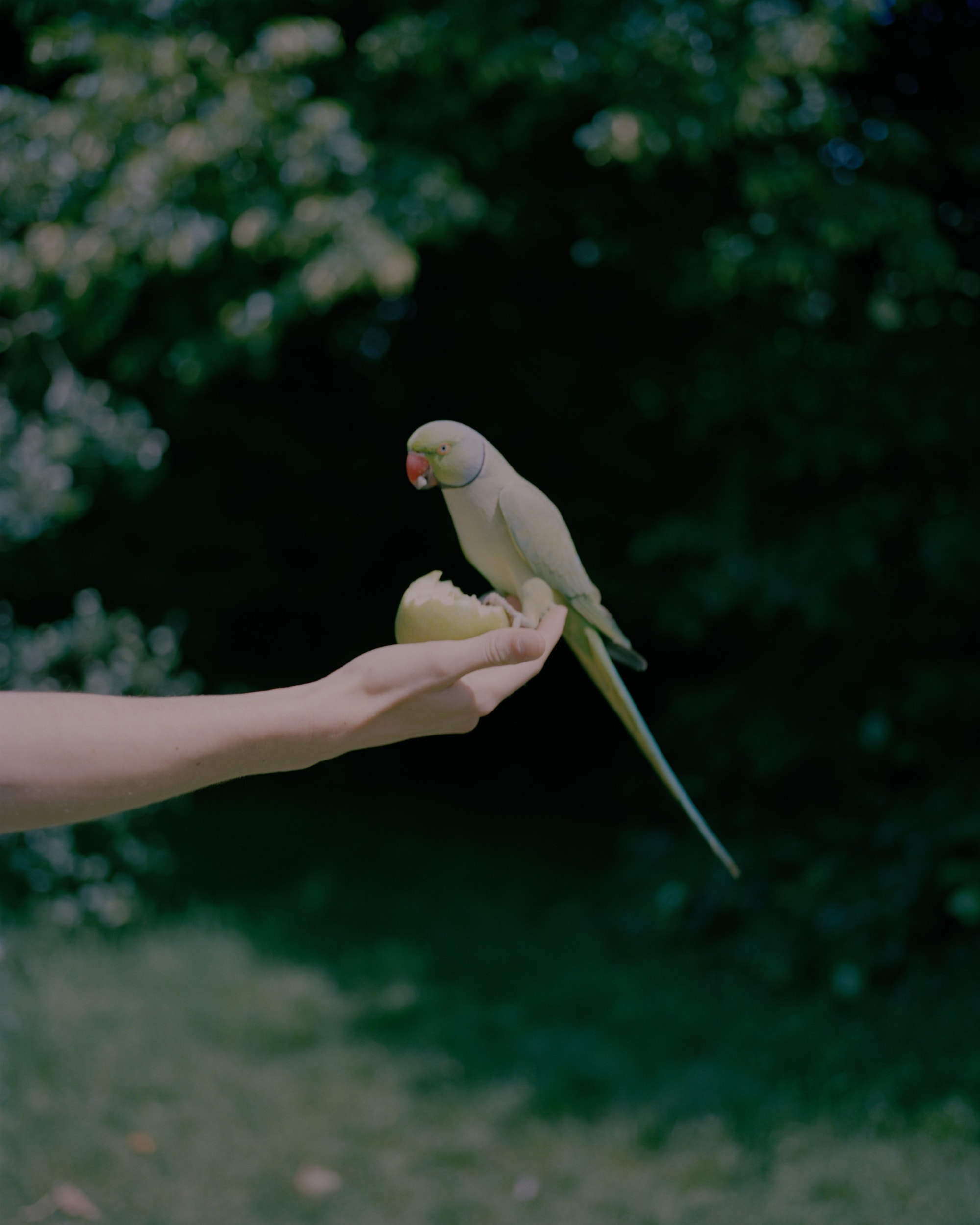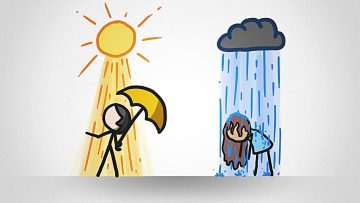
I don’t know exactly how the parakeets came into my life. I knew they were out there, somewhere, but I’d never paid much attention before. Until lockdown that is, when they suddenly became visible to me. Flying over each evening as if they’d burst from the jungles of Costa Rica – and by the sounds and look of it they were having an absolute riot.
I confess that initially, I suffered from what I can only describe as parakeet fomo (fear of missing out). I wanted to know where they were going, what they were doing and how had they got here? But when it became clear that they were too fast for me – even my eyes struggled to keep up – my eagerness to join them settled into a distant appreciation and growing curiosity.
Array
Parakeets fly from their roost in Richmond Park on October 11, 2008. (Photo by Dan Kitwood/Getty Images)
The earliest sightings of wild parakeets in London date back to 1893 when a pair was reported in Dulwich. From there they began their great expansion, establishing themselves first in Kingston upon Thames, and later crossing the river northeast towards Regent’s Park and along Regent’s Canal to Hackney and Walthamstow Marshes.
The parakeets have since been identified as the Indian subspecies (Pstittacula krameri manillensis), which populate the foothills of the Himalayas and some of North Africa’s more temperate regions. But exactly how they ended up in the UK capital remains a mystery that not even the most experienced ornithologists have been able to solve.
According to a 2012 roost count, it was estimated that there are around 32,000 parakeets in London. The current population is believed to be much higher.

The Lightness © Alexander Mourant, 2018
Last summer I moved to a different part of London and thought the parakeets would become a distant memory, enmeshed with other early lockdown memories from when the world started to turn weird.
But it turns out that my current flat is situated on a parakeet ‘flyway’, an aerial circuit through the city that the birds use each morning and evening with the punctuality of commuters.
Growing up in Brighton, I recall a similar bird ritual where starlings would murmurate around the pier at dusk. It was like they were tuned into a special avian frequency, commanded by a mysterious life force far greater than ourselves.
ArrayA Parakeet sits in a bush in St James’s Park on a cold winter’s day on November 30, 2012. (Photo by Dan Kitwood/Getty Images)
But unlike the hypnotic formations of starlings that ripple en masse across the sky like a bullfighter’s muleta, the parakeets fly in squadrons, military-style, slicing through the air as green arrows.
When on the flyways, they travel with the flamboyance of party-goers, operating on a different time schedule, shooting past as if on an invisible zip wire (they also remind me of the Beauxbatons from Harry Potter and the Goblet of Fire).
Seeing the fly-bys makes you want to drop everything and go with them – at least, that’s how I feel.

The Lightness © Alexander Mourant, 2018
Often you’ll hear them before seeing them. Loud, incessant squawking from somewhere up in the trees. A ‘pandemonium’ is the collective noun for parrots and it makes sense, for the noise is not something you can ignore.
According to The Independent, London contains 3,000 parks, roughly 30,000 allotments and 3 million private gardens, which amasses to 47% green space (the city falls within the UN definition of a forest after all).
It seems that parakeets have been using the flyways to join the dots, orbiting the city’s green spaces and creating a kind of parakeet psychogeographic map of the capital.
Array“Like counter culture, they started on the margins and eventually colonised the centre”
Myths abound when it comes to the origins of how these birds arrived in London. There’s the Hendrix origin myth, which claims the birds derived from a pair of birds released by Jimi Hendrix as a gesture of free love on Carnaby Street. Although this has been branded by some as “absolute rubbish” and his girlfriend at the time (Kathy Etchingham) denies that Jimi ever owned parakeets.
Then there’s the Great Storm myth which traces the parakeets back to the Great Storm of 1987, where the birds may or may not have escaped from destroyed aviaries in Kew Gardens.

Print of a view of the Aviary in the Royal Botanic Gardens, Kew, now demolished, by June from the mid 18th century. Unknown artist.
Others believe the birds escaped from the set of The African Queen filmed at Shepperton Studios, or are convinced that the original avians were released in a drunken frenzy from a house that George Michael shared with Boy George in Brockley in the early nineties.
It’s easy to get caught up in the parakeet folklore. But as alluring as all these origin myths sound, the real reason is probably less fantastical. It’s likely that concerns around ‘parrot fever’ (Psittacosis) – which proliferated in the booming exotic pet trade of the 1960s-70s – led some owners to liberate the birds on purpose.
Academic ornithologists believe the most plausible explanation is due to multiple escapes on multiple occasions.
Array“Parakeets, we soon discovered, are never just parakeets. They’re blank canvases onto which people project their own values.”
A few years ago, writer Nick Hunt and photographer Tim Mitchell embarked on a mission to gauge people’s opinions on these birds and spoke with number of people from all walks of life including park keepers, joggers, drunks, tourists, shop-keepers, fishermen, monarchists, undertakers, Polish grave-diggers and Albanian ice cream sellers. Their resulting book The Parakeeting of London (2019) demonstrates the polarity of views when it comes to parakeets.
From their interviews, Nick and Tim distinguished two dominant opinions on the birds: the first “condemned them as aggressive bullies” and the other “praised them as paragons of peaceful coexistence.”

The Lightness © Alexander Mourant, 2018
Some fear their raucous and occasionally aggressive behaviour is driving the decline of native birds. While the full impact of parakeets on indigenous bird population is unclear, fruit-growers have experienced firsthand how destructive these birds can be (owing to their penchant for fruits), which has led to a controversial YouTube video demonstrating how to shoot the birds.
In the book, Nick notes how parakeet conversations swiftly strayed into other subjects, including immigration. “In the course of a typical conversation, it never took long for people to leap from the avian to the human. They passed unthinkingly from one species to the other, often without being aware of the anthropomorphism. Parakeet and human immigration were conflated instinctively.
“In a city as diverse as London where multiculturalism is a fact of daily life – where, according to the latest census, more than a third of residents were born in a foreign country (and of the two thirds that are British, a large proportion were born outside of London) many we met welcomed green birds to the mix.”
Parakeet and human immigration were conflated instinctively
However, many others do not share the same sentiment. One man they speak to says: “I believe they need culling. They shouldn’t be here… When I was a boy starlings were out there. Where’ve they gone? We’ve fucked it for them.”
In 2009, the government added the rose-ringed parakeet to the list of pest species that can be lawfully killed without a permit, provided they present a serious threat to livestock, public safety or the conservation of wild birds, but there has yet to be a general cull.
Array“You see parakeets and you assume warmth and sunshine”
The first time you see a parakeet in London you’re likely to be confused, alarmed even. You’ll wonder if what you just saw was real, or a figment of your imagination. It’s not only the speed and hue of the birds, but the sound. The high pitch, melody-less squawking that jars with the urban sounds we’re accustomed to.
It’s not a sound or a sight you associate with London, especially when you see them fly by on a January afternoon. We associate wild parrots with tropical climates, not cold, grey England. Could they be a sign of something darker, a warning perhaps?
Birds have, in fact, long been associated with myths and omens and many ancient people believed them to be messengers from the gods, or even embodiments of the gods themselves. Like the love birds in Hitchcock’s The Birds they act as portents, signs of bad things to come.

Rose-ringed parakeets are caught, ringed and marked with red dye on Wormwood Scrubs by ‘British Trust for Ornithology’ volunteers as part of a project to try to better understand their behaviour on August 8, 2012 in London, England. (Photo by Oli Scarff/Getty Images)
“In ecology there’s the concept of an ‘indicator species’ which acts as an early warning of environmental fluctuations,” explains Nick. “Lichens, highly sensitive to air pollution, are good examples of these, thriving when the air is clean and vanishing when it is toxic.”
“Many of the people we spoke to felt intuitively that parakeets are indicators of globally rising temperatures – or even climate refugees fleeing north as the planet warms.”
He also draws attention to the idea of “shifting baseline syndrome”, which refers to our perception of ‘normal’ changing over time, and “solastalgia” – a form of psychic or existential distress caused by environmental change.
“This, perhaps, is at the root of why parakeets feel disturbing to some people, especially older Londoners,” Nick says. “Their appearance causes small flutters of pain, an aching reinforcement of a new normal that feels profoundly weird.”
ArrayParakeets Are Surveyed As They Come To Roost At Wormwood Scrubs
It’s not just in London that parakeets are flourishing. During summertime these birds have been spotted as far afield as Glasgow. Across Europe too, from Palermo to Helsinki, Lisbon to Istanbul, parakeets are on the rise. Yet London seems to be the favoured destination of all European cities so far.
When I first saw them last year, I started asking friends whether they’d seen the parakeets too, as if to confirm I wasn’t dreaming. And I discovered that almost everyone I know living in London has a parakeet story, that these birds have gradually become part of the city’s collective imagination – even if we haven’t consciously noticed it happening ourselves.
An environment’s ability to surprise diminishes in direct proportion to the time you spend in it
Putting aside for a moment any destructive behaviours they might possess, there is an undeniable sense of joy in seeing the parakeets, especially when we’re confined as we are to our homes. They invite us to see the city with fresh eyes and act as a reminder to never stop being fascinated by the world around us.
Nick calls this ‘re-enchantment’. “When you live in a place for a long time you often stop noticing it,” he writes at the close of his book. “An environment’s ability to surprise diminishes in direct proportion to the time you spend in it; it can seem like there’s nothing left to explore, nothing new to discover. Sometimes it takes a visitor to open your eyes again – and the parakeets have that effect.
“In an age where people are becoming increasingly disconnected from nature, unable to name common birds or plants, lost in the screenglow of their phones, parakeets insinuate themselves into everyday thoughts and conversations, a provocation to look up and pay attention.”




